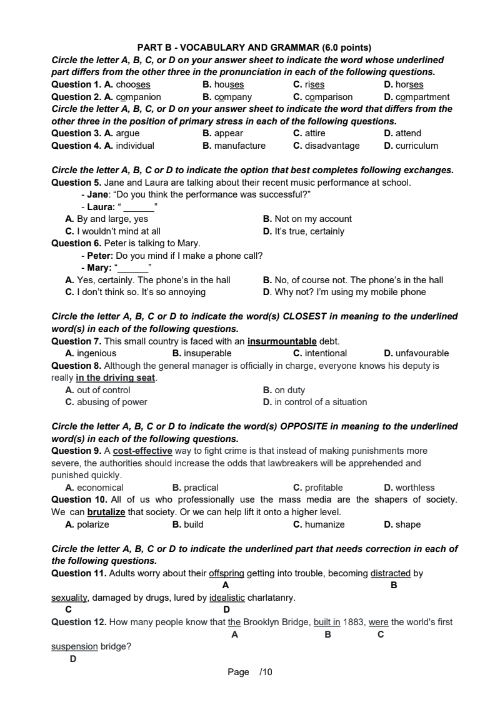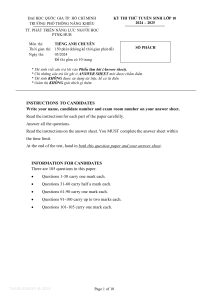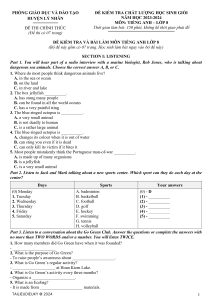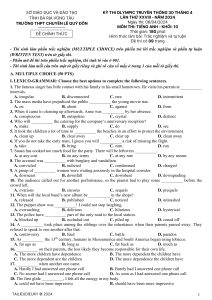Bạn đang chuẩn bị cho kỳ thi HSG THPT sắp tới và muốn tìm tài liệu ôn luyện hiệu quả? Hãy khám phá tài liệu "ĐỀ THI CHỌN HỌC SINH GIỎI NĂM HỌC 2021 - 2022 Môn TIẾNG ANH – Lớp 12 THPT Tỉnh NAM ĐỊNH" tại website Tài liệu diệu kỳ. Tài liệu này có thể được tải xuống dưới dạng file PDF để bạn tiện tham khảo và ôn tập.
Trong đề thi này, bạn sẽ tìm thấy nhiều câu hỏi thú vị và thách thức về môn Tiếng Anh dành cho học sinh lớp 12. Nó cung cấp cho bạn cơ hội rèn luyện kỹ năng làm bài, nắm bắt cấu trúc và dạng bài thi, đồng thời giúp bạn ôn tập hiệu quả và đạt thành tích cao trong kỳ thi chọn học sinh giỏi.
Ngoài ra, website Tài liệu diệu kỳ còn cung cấp một loạt các tài liệu liên quan khác mà bạn có thể tham khảo để nâng cao kiến thức và kỹ năng của mình. Bạn có thể tìm thấy tài liệu ôn luyện cho các kỳ thi HSG THPT khác, ôn luyện bồi dưỡng cho đội tuyển học sinh giỏi THPT, và nhiều tài liệu hữu ích khác.
Đừng bỏ lỡ cơ hội ôn tập hiệu quả với tài liệu "ĐỀ THI CHỌN HỌC SINH GIỎI NĂM HỌC 2021 - 2022 Môn TIẾNG ANH – Lớp 12 THPT Tỉnh NAM ĐỊNH" và các tài liệu khác trên website Tài liệu diệu kỳ. Hãy chuẩn bị tốt cho kỳ thi của bạn và đạt được kết quả cao trong học tập và các cuộc thi quan trọng.
Trích dẫn nội dung "ĐỀ THI CHỌN HỌC SINH GIỎI NĂM HỌC 2021 – 2022 Môn TIẾNG ANH – Lớp 12 THPT tỉnh NAM ĐỊNH":
ĐỀ THI CHỌN HỌC SINHGIỎI
SỞ GIÁO DỤC VÀ ĐÀO TẠO
NĂM HỌC 2021 - 2022
NAM ĐỊNH
Môn: TIẾNG ANH – Lớp: 12 THPT
Thời gian làm bài: 120 phút
Đề thi gồm: 10 trang.
Họ, tên và chữ ký 2 giám khảo
Điểm
Bằng số: .............................Bằng chữ: ..........................
bài thi
Giám khảo 1: ..............................……………...
Giám khảo 2: .............................……………....
SỐPHÁCH
Lưu ý: Thí sinh làm bài vào đề thi này.
PART A - LISTENING (4.0 points)
Hướng dẫn làm phần thi nghe hiểu:
- Bài nghe gồm 20 câu, thí sinh được nghe 2 lần, đĩa CD tự chạy 2 lần. - Mở đầu và kết thúc bài nghe có tín hiệu nhạc, hướng dẫn chi tiết đã có trong bài nghe. SECTION 1 : Question 1-10
Question 1 - 4
Complete the following information about the cars available for rental using. Write NO MORE THAN THREE WORDS or A NUMBER for each answer.
Name
Size
Miles per gallon
Price*
IOTA
Small
20
$23
COMBI
Medium
18
$28.75
ROADSTER
1…………….……..
2…………..………..
3………..…….…..
Price* include tax and 4 ………………………………
Question 5 – 7
Complete the following information using NO MORE THAN THREE WORDS or ANUMBERfor each answer.
Name: David 5 ……………………………….
Company: 6 ...……………………………………..
Adress 7……………………….. Arlington Close, Beddleton, Yorkshire. Telephone 0675934888
Questions 8 – 10
Complete the following sentences.
In the car, there is a 8 ………………………………………. and a torch. The registration number of the car is 9 ………………………………….
The car uses a 10 ………………………….. locking system.
SECTION 2: Questions 11 - 20
Question 11 - 15
Complete the diagram below.
Write NO MORE THAN THREE WORDS and/or A NUMBER for each answer.
Page /10
11. ..……………………………………….
12. ..……………………………………….
Question 13-15
Complete the sentences below.
Write NO MORE THAN THREE WORDS and/or A NUMBER for each answer. Taylor wrote his theory in the 13 …………………….………………. century.
Taylor’s theory was that people only worked for 14 …………………….………………. Later research concluded that some people preferred to work 15 …………………….……………
Question 16 - 20
What feature do the speakers identify for each of he followin courses? Choose FIVE answers from the box and write the correct letters, A-G, next to questions 16-20.
Courses
16. Travel and Business ________
17. Japanese ________
18. Medical Care ________
19. Computer ________
20. Public Relations ________
Page /10
PART B - VOCABULARY AND GRAMMAR (6.0 points)
Circle the letter A, B, C, or D on your answer sheet to indicate the word whose underlinedpart differs from the other three in the pronunciation in each of the following questions. Question 1. A. chooses B. houses C. rises D. horsesQuestion 2. A. companion B. company C. comparison D. compartment Circle the letter A, B, C, or D on your answer sheet to indicate the word that differsfromtheother three in the position of primary stress in each of the following questions. Question 3. A. argue B. appear C. attire D. attendQuestion 4. A. individual B. manufacture C. disadvantage D. curriculum
Circle the letter A, B, C or D to indicate the option that best completes followingexchanges.Question 5. Jane and Laura are talking about their recent music performance at school. - Jane: “Do you think the performance was successful?”
- Laura: “ ______”
A. By and large, yes B. Not on my account C. I wouldn’t mind at all D. It’s true, certainly Question 6. Peter is talking to Mary.
- Peter: Do you mind if I make a phone call?
- Mary: “______”
A. Yes, certainly. The phone’s in the hall B. No, of course not. The phone’s inthehall C. I don’t think so. It’s so annoying D. Why not? I’m using my mobile phone
Circle the letter A, B, C or D to indicate the word(s) CLOSEST in meaning to theunderlinedword(s) in each of the following questions.
Question 7. This small country is faced with an insurmountable debt. A. ingenious B. insuperable C. intentional D. unfavourableQuestion 8. Although the general manager is officially in charge, everyone knows his deputyisreally in the driving seat.
A. out of control B. on duty
C. abusing of power D. in control of a situation
Circle the letter A, B, C or D to indicate the word(s) OPPOSITE in meaning to theunderlinedword(s) in each of the following questions.
Question 9. A cost-effective way to fight crime is that instead of making punishments moresevere, the authorities should increase the odds that lawbreakers will be apprehendedandpunished quickly.
A. economical B. practical C. profitable D. worthlessQuestion 10. All of us who professionally use the mass media are the shapers of society.We can brutalize that society. Or we can help lift it onto a higher level. A. polarize B. build C. humanize D. shape
Circle the letter A, B, C or D to indicate the underlined part that needs correctionineachofthe following questions.
Question 11. Adults worry about their offspring getting into trouble, becoming distractedbyA B
sexuality, damaged by drugs, lured by idealistic charlatanry.
C D
Question 12. How many people know that the Brooklyn Bridge, built in 1883, were theworld'sfirstA B C
suspension bridge?
D
Page /10
Question 13. Although the destruction that it causes is often terrible, cyclones benefit amuchA BC
wider belt than they devastate.
D
Circle the letter A, B, C or D to indicate the correct answer to each of the following questions. Question 14. She gave me a ______ box.
A. jewelry metal small square B. jewelry small metal squareC. small square jewelry metal D. small square metal jewelryQuestion 15. In 2006, Larry Stewart was diagnosed ______ cance, which later claimedhislife. A. on B. with C. of D. about Question 16. David had a lucky escape. He ______ in that car crash.
A. Should haven been killed B. must have been killed C. ought to have been killed D. could have been killed Question 17. I found the flight rather uncomfortable, to ______ the least. A. call B. say C. tell D. talk Question 18. I don’t think students who volunteer in high school will continue to volunteer throughout their lives, ______?
A. don’t I B. do I C. will they D. won’t theyQuestion 19. Directly in front of them ______.
A. did a great castle stand B. stood a great castle C. a great castle stood D. a great castle did stand Question 20. The computer system crashed on Monday, then again on Wednesday andfinallytoday. These ______ breakdowns are wasting us time and costing us a lot of money. A. continuing B. continuous C. continued D. continual Question 21. He will drop you a line ______.
A. after he settled down in his new house
B. as soon as he has settled down in his new house
C. when he settled down in his new house
D. till he settles down in his new house
Question 22. Practise ______ arithmetic when you go out shopping.
A. spiritual B. physical C. mental D. natural Question 23. Her fiancé is said ______ from Harvard University five years ago. A. having graduated B. to have graduated C. being graduated D. to begraduatedQuestion 24. While Jane’s brother’s house is covered with dust, her flat is always ______clean. A. horrendously B. meticulously C. ravenously D. stunninglyQuestion 25. Henry was a studious student. He needed no ______ to work hard. A. encourage B. encouraging C. encouragement D. encouragedQuestion 26. On being told about her sack, ______.
A. Her boss felt sorry for Mary B. Mary was shocked C. Mary’s face turned pale D. her boss changed his attitudeQuestion 27. Your chair may ______ on the cobblestones, but your dinner will be superb. A. sway B. wobble C. wiggle D. wriggleQuestion 28. ______, I still was able to get to the top of the mountain. A. Even though unfit B. Unfit as I was C. While ever out of condition D. Much as I’munfit Question 29. It is possible that at this election some of the minority parties might succeedin______ into parliament.
A. breaking out B. breaking away C. breaking through D. breakingupQuestion 30. It is said that when Donald Trump downplayed the severity of COVID-19, helet thegenie out of the ______: the damage that mostly resulted from this attitude was irreversible. A. cave B. lamp C. bottle D. chest
Page /10
PART C - READING (6.0 points)
I. Read the following passage and circle the letter A, B, C or D to indicate the correct answerto each of the questions.
The money that some professional sportsmen earn shouldn’t impress anyone whenyoutakeinto consideration the fact that only a few of them manage to attain (1) ______ andeverlastingfame. And once they reach their (2) ______ and display their talent at their best, theyarefullyconscious that their brilliant careers won’t last forever. They live under a constant pressureof being(3) ______ and subsequently replaced by someone who is younger, faster and more accomplished.For that reason, objectives like retirement benefits and pensions are (4) ______ great concerntoall professional athletes.
Some of the retired competitors go as far as to organize strikes and rallies tovoicetheirprotest against any policy unresponsive to their demand (5) ______ the younger professionalsseekmore upgrading solutions to the problem as more and more of them attach a proper significanceto(6) ______ a solid education, even at university level. Such an approach should helpthemfindinteresting and well-paid jobs (7) ______ their sports career is over.
A completely new strategy has been devised by the schools priding themselves (8) ______supporting their own teams. Their authorities insist that the sports clubs members achievehighacademic standards or else they are debarred from partaking in certain sports events, (9)______may lead to further disruption in their professional careers.
By these practical and most effective means, combining education with sports activity, the(10)______ of the professional athlete as being brainless and unintelligent may eventually bechangingto the sportsmen’s benefit.
Question 1. A. immortalised B. immortalise C. immortal D. immortalityQuestion 2. A. prime B. shape C. best D. capacityQuestion 3. A. outcast B. outshone C. outstayed D. outgrownQuestion 4. A. with B. in C. at D. of
Question 5. A. whereby B. whereas C. whereupon D. whereinQuestion 6. A. mastering B. learning C. receiving D. attendingQuestion 7. A. right away B. promptly C. barely D. onceQuestion 8. A. with B. on C. for D. inQuestion 9. A. which B. where C. what D. that Question 10. A. vision B. outlook C. image D. judgment II. Read the following passage and circle the letter A, B, C or D to indicate the correct answer to each of the questions.
Researchers in the field of psychology have found that one of the best ways tomakeanimportant decision, such as choosing a university to attend or a business to invest in, involvestheutilization of a decision worksheet. Psychologists who study optimization comparetheactual decisions made by people to theoretical ideal decisions to see how similar they are. Proponentsofthe worksheet procedure believe that it will yield optimal, that is, the best decisions. Althoughthereare several variations on the exact format that worksheets can take, they are all similar intheiressential aspects. Worksheets require defining the problem in a clear and concise wayandthenlisting all possible solutions to the problem. Next, the pertinent considerations that will beaffectedby each decision are listed, and the relative importance of each consideration or consequenceisdetermined. Each consideration is assigned a numerical value to reflect its relative importance. Adecision is mathematically calculated by adding these values together. The alternativewiththehighest number of points emerges as the best decision.
Since most important problems are multifaceted, there are several alternativestochoose from, each with unique advantages and disadvantages. One of the benefits of apencil andpaper decision-making procedure is that it permits people to deal with more variablesthantheirminds can generally comprehend and remember. On the average, people can keepabout seven
Page /10
ideas in their minds at once. A worksheet can be especially useful when the decisioninvolvesalarge number of variables with complex relationships. A realistic example for many collegestudentsis the question "What will I do after graduation?" A graduate might seek a positionthat offersspecialized training, pursue an advanced degree, or travel abroad for a year.
A decision-making worksheet begins with a succinct statement of the problemthat will alsohelp to narrow it. It is important to be clear about the distinction between long-range andimmediategoals because long-range goals often involve a different decision than short-range ones. Focusingon long-range goals, a graduating student might revise the question above to "What will I doaftergraduation that will lead to a successful career?"
(Adapted from TOEFL Reading Comprehension)
Question 1. What does the passage mainly discuss?
A. A tool to assist in making complex decisions.
B. A comparison of actual decisions and ideal decisions
C. Research on how people make decisions
D. Differences between long-range and short-range decision making Question 2. The word "essential" in line 7, paragraph 1, is closest in meaning to ______. A. introductory B. changeable C. beneficial D. fundamental Question 3. The word "pertinent" in line 8, paragraph 1, is closest in meaning to ______. A. relevant B. preceding B. insightful D. responsiveQuestion 4. Of the following steps, which occurs before the others in making a decisionworksheet?A. Listing the consequences of each solution
B. Calculating a numerical summary of each solution
C. Deciding which consequences are most important
D. Writing down all possible solutions
Question 5. According to decision-worksheet theory, an optimal decision is definedasonethat______.
A. has the fewest variables to consider B. uses the most decision worksheets C. has the most points assigned to it D. is agreed to by the greatest number of peopleQuestion 6. The author develops the discussion in paragraph 1 by means of ________. A. describing a process B. classifying types of worksheets C. providing historical background D. explaining a theory Question 7. The author states that "On the average, people can keep about sevenideasintheir minds at once” in paragraph 2 to explain that ______.
A. most decisions involve seven steps
B. human mental capacity has limitations
C. some people have difficulty making minor as well as major decisions D. people can learn to keep more than seven ideas in their minds with practice Question 8. The word "succinct "in line 21, paragraph 3, is closest in meaning to ______. A. creative B. satisfactory C. personal D. conciseQuestion 9. The word "it" in line 25 refers to ______.
A. worksheet B. problem C. distinction D. decisionQuestion 10. The word "revise" in line 24, paragraph 3, is closest in meaning to ______. A. ask B. explain C. change D. predict III. Read the following passage and circle the letter A, B, C or D to indicate the correct answer to each of the questions.
Throughout the nineteenth century and into the twentieth, citizens of the UnitedStatesmaintained a bias against big cities. Most lived on farms and in small towns and believedcitiestobe centers of corruption, crime, poverty, and moral degradation. Their distrust was caused, inpart,by a national ideology that proclaimed farming the greatest occupation and rural livingsuperiortourban living. This attitude prevailed even as the number of urban dwellers increasedandcities
Page /10
became an essential feature of the national landscape. Gradually, economic realityovercameideology. Thousands abandoned the precarious life on the farm for more secure and better payingjobs in the city. But when these people migrated from the countryside, they carried their fearsandsuspicious with them. These new urbanities, already convinced that cities were overwhelmedwithgreat problems, eagerly embraced the progressive reforms that promised to bring order out of thechaos of the city.
One of many reforms came in the area of public utilities. Water and sewerage systemswereusually operated by municipal governments, but the gas and electric networks wereprivatelyowned. Reformers feared that the privately owned utility companies would charge exorbitant ratesfor these essential services and deliver them only to people who could afford them. Somecityandstate governments responded by regulating the utility companies, but a number of citiesbegantosupply these services themselves. Proponents of these reforms argued that public ownershipandregulation would insure widespread access to these utilities and guarantee a fair price.
While some reforms focused on government and public behavior, others lookedat thecitiesas a whole. Civic leaders, convinced that physical environment influenced human behavior, arguedthat cities should develop master plans to guide their future growth and development. Cityplanningwas nothing new, but the rapid industrialization and urban growth of the late nineteenthcenturytook place without any consideration for order. Urban renewal in the twentieth centuryfollowedseveral courses. Some cities introduced plans to completely rebuild the city core. Most other citiescontented themselves with zoning plans for regulating future growth. Certain parts of townwererestricted to residential use, while others were set aside for industrial or commercial development. (Adapted from TOEFL Reading Comprehension)
Question 1. What does the passage mainly discuss?
A. A comparison of urban and rural life in the early twentieth century B. The role of government in twentieth-century urban renewal
C. Efforts to improve urban life in the early twentieth century
D. Methods of controlling urban growth in the twentieth century Question 2. The word "bias" in line 2, paragraph 1, is closest in meaning to ______. A. diagonal B. slope C. distortion D. prejudiceQuestion 3. The first paragraph suggests that most people who lived in rural areas ______. A. were suspicious of their neighbors
B. were very proud of their lifestyle
C. believed city government had too much power
D. wanted to move to the cities
Question 4. In the early twentieth century, many rural dwellers migrated to the city in order to______.
A. participate in the urban reform movement
B. seek financial security
C. comply with a government ordinance
D. avoid crime and corruption
Question 5. The word "embraced" in line 10, paragraph 1, is closest in meaning to ______. A. suggested B. overestimated C. demanded D. welcomedQuestion 6. What concern did reformers have about privately owned utility companies?A. They feared the services would not be made available to all city dwellers. B. They believed private ownership would slow economic growth C. They did not trust the companies to obey the government regulations. D. They wanted to ensure that the services would be provided to rural areas. Question 7. The word "exorbitant" in line 14, paragraph 2, is closest in meaning to ______. A. additional B. expensive C. various D. modified
Page /10
Question 8. All of the following were the direct result of public utility reforms EXCEPT______. A. local governments determined the rates charged by private utility companies B. some utility companies were owned and operated by local governments C. the availability of services was regulated by local government
D. private utility companies were required to pay a fee to local governments Question 9. The word "Proponents" in line 17, paragraph 2, is closest in meaning to ______. A. Experts B. Pioneers C. Reviewers D. SupportersQuestion 10. Why does the author mention "industrialization" in the last paragraph?A. To explain how fast urban growth led to poorly designed cities B. To emphasize the economic importance of urban areas
C. To suggest that labor disputes had become an urban problem D. To illustrate the need for construction of new factories
PART D - WRITING (4.0 points)
I. Finish each of the following sentences in such a way that it means exactly the sameasthesentence printed before it. Write your answers in the spaces provided. (0) has beendoneasan example (1.0 points)
0. She has learnt English for three years.
-> She started learning English three years ago.
Question 1. Peter said that he had failed as a result of carelessness.
🖎 He attributed __________________________________________________________________.Question 2. Harmful chemicals released into the environment can cause health problems. 🖎 Health problems can result _______________________________________________________.Question 3. His video of himself mimicking his favourite Tik Tok idol was so funny that it receivedone million views in just a day.
🖎 So ____________________________________________________________________________________________________________________________________________________.Question 4. The motorcyclist rounded the corner at a quite unbelievable speed. 🖎 The speed ___________________________________________________________________.Question 5. I was shocked when I heard that the war between Russia and Ukraine hadbrokenout.🖎 It came ______________________________________________________________________.II. Rewrite the following sentences with the given words in such a way that thesecondsentence has the same meaning as the first one. Do not change the formof thewordsinbrackets. (0) has been done as an example. (1.0 point)
(0). I never have enough money. SHORT
🖎 I am always short of money.
Question 1. Don’t worry you will be well taken care of at the hospital. GOOD🖎 ____________________________________________________________________________.Question 2. What he said is evidence of the fact that he’s a liar. WITNESS🖎 ____________________________________________________________________________.Question 3. Peter reckoned that his success was due to incredible luck. PUT🖎 ____________________________________________________________________________.Question 4. I wrote this book because I want to help my students with their writing. VIEW🖎 ____________________________________________________________________________.Question 5. I found the story too complicated to understand. HEAD🖎 ____________________________________________________________________________.
Page /10
III. Writing essay (2 points)
Write an essay (at least 200 words) about the following topic:
Nowadays, many high schools and universities prioritise students having international English language certificates. Is it a positive or negative policy? What is your opinion? Give reasons for your answer and include any relevant examples fromyourown knowledge or experience.
….………………………………………………………………………………………………………………….………………………………………………………………………………………………………………….………………………………………………………………………………………………………………….………………………………………………………………………………………………………………….………………………………………………………………………………………………………………….………………………………………………………………………………………………………………….………………………………………………………………………………………………………………….………………………………………………………………………………………………………………….………………………………………………………………………………………………………………….………………………………………………………………………………………………………………….………………………………………………………………………………………………………………….………………………………………………………………………………………………………………….………………………………………………………………………………………………………………….………………………………………………………………………………………………………………….………………………………………………………………………………………………………………….………………………………………………………………………………………………………………….………………………………………………………………………………………………………………….………………………………………………………………………………………………………………….………………………………………………………………………………………………………………….………………………………………………………………………………………………………………….………………………………………………………………………………………………………………….………………………………………………………………………………………………………………….………………………………………………………………………………………………………………….………………………………………………………………………………………………………………….………………………………………………………………………………………………………………….………………………………………………………………………………………………………………….………………………………………………………………………………………………………………….………………………………………………………………………………………………………………….………………………………………………………………………………………………………………….………………………………………………………………………………………………………………….………………………………………………………………………………………………………………….………………………………………………………………………………………………………………….………………………………………………………………………………………………………………….………………………………………………………………………………………………………………….………………………………………………………………………………………………………………
Page /10
….………………………………………………………………………………………………………………….………………………………………………………………………………………………………………….………………………………………………………………………………………………………………….………………………………………………………………………………………………………………….………………………………………………………………………………………………………………….………………………………………………………………………………………………………………….………………………………………………………………………………………………………………….………………………………………………………………………………………………………………….………………………………………………………………………………………………………………….………………………………………………………………………………………………………………….………………………………………………………………………………………………………………….………………………………………………………………………………………………………………….………………………………………………………………………………………………………………….………………………………………………………………………………………………………………….………………………………………………………………………………………………………………….………………………………………………………………………………………………………………….………………………………………………………………………………………………………………….………………………………………………………………………………………………………………….………………………………………………………………………………………………………………….………………………………………………………………………………………………………………….………………………………………………………………………………………………………………….………………………………………………………………………………………………………………….………………………………………………………………………………………………………………….………………………………………………………………………………………………………………….………………………………………………………………………………………………………………….………………………………………………………………………………………………………………….………………………………………………………………………………………………………………….………………………………………………………………………………………………………………….………………………………………………………………………………………………………………….………………………………………………………………………………………………………………….………………………………………………………………………………………………………………….………………………………………………………………………………………………………………….………………………………………………………………………………………………………………….………………………………………………………………………………………………………………….………………………………………………………………………………………………………………….………………………………………………………………………………………………………………….………………………………………………………………………………………………………………….………………………………………………………………………………………………………………---------- THE END ----------
Page /10



